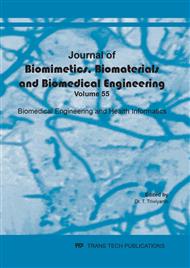[1]
K. John W, Arm Function after Stroke From Physiology,, Semin. Neurol., vol. 25, no. 4, p.384–395, (2005).
Google Scholar
[2]
T. Triwiyanto, I. P. A. Pawana, B. G. Irianto, T. B. Indrato, and I. D. G. H. Wisana, Embedded system for upper-limb exoskeleton based on electromyography control,, Telkomnika (Telecommunication Comput. Electron. Control., vol. 17, no. 6, p.2992–3002, (2019).
DOI: 10.12928/telkomnika.v17i6.11670
Google Scholar
[3]
D. Leonardis et al., An EMG-controlled robotic hand exoskeleton for bilateral rehabilitation,, IEEE Trans. Haptics, vol. 8, no. 2, p.140–151, (2015).
DOI: 10.1109/toh.2015.2417570
Google Scholar
[4]
N. S. K. Ho et al., An EMG-driven Exoskeleton Hand Robotic Training Device on Chronic Stroke Subjects Task Training System for Stroke Rehabilitation,, in 2011 IEEE International Conference on Rehabilitation Robotics, (2011).
DOI: 10.1109/icorr.2011.5975340
Google Scholar
[5]
A. Pascual-Leone, Robot-assisted Therapy in Stroke Rehabilitation.,, J. stroke, vol. 15, no. 3, p.174–81, (2013).
Google Scholar
[6]
J. J. Dowling, The use of electromyography for the noninvasive prediction of muscle forces. Current issues.,, Sports medicine (Auckland, N.Z.), vol. 24, no. 2. p.82–96, (1997).
DOI: 10.2165/00007256-199724020-00002
Google Scholar
[7]
F. H. Martini, J. L. Nath, and E. F. Barholomew, Fundamental of Anatomy and Physiology, 9th ed. Boston: Pearson Education, (2012).
Google Scholar
[8]
M. Asghari Oskoei and H. Hu, Myoelectric control systems—A survey,, Biomed. Signal Process. Control, vol. 2, no. 4, p.275–294, Oct. (2007).
DOI: 10.1016/j.bspc.2007.07.009
Google Scholar
[9]
R. Tavares, P. Abreu, and M. R. Quintas, Data acquisition glove for hand movement impairment rehabilitation,, Int. J. Online Eng., vol. 12, no. 4, p.52–54, (2016).
DOI: 10.3991/ijoe.v12i04.5141
Google Scholar
[10]
T. R. Munusamy, Hand Pattern Recognition Using Smart Band,, University of Arkansas, Fayetteville, (2015).
Google Scholar
[11]
P. Laferriere, E. D. Lemaire, and A. D. C. Chan, Surface Electromyographic Signals Using Dry Electrodes,, IEEE Trans. Instrum. Meas., vol. 60, no. 10, p.3259–3268, (2011).
DOI: 10.1109/tim.2011.2164279
Google Scholar
[12]
J. V Basmajian and C. J. De Luca, Chapter1: introduction,, Muscles Alive their Funct. Reveal. by Electromyogr., p.1–18, (1985).
Google Scholar
[13]
Triwiyanto, O. Wahyunggoro, H. A. Nugroho, and Herianto, An investigation into time domain features of surface electromyography to estimate the elbow joint angle,, Adv. Electr. Electron. Eng., vol. 15, no. 3, p.448–458, (2017).
DOI: 10.15598/aeee.v15i3.2177
Google Scholar
[14]
A. Bhattacharya, A. Sarkar, and P. Basak, Time domain multi-feature extraction and classification of human hand movements using surface EMG,, 2017 4th Int. Conf. Adv. Comput. Commun. Syst. ICACCS 2017, p.1–5, (2017).
DOI: 10.1109/icaccs.2017.8014594
Google Scholar
[15]
P. Konrad, The ABC of EMG (A Practical Introduction to Kinesiological Electromyography),, Arizona, (2005).
Google Scholar
[16]
H.J. Hermens and B Freriks, SENIAM Project,, SENIAM Proj., p.1, (2017).
Google Scholar
[17]
T. Triwiyanto, O. Wahyunggoro, H. A. Nugroho, and H. Herianto, Muscle fatigue compensation of the electromyography signal for elbow joint angle estimation using adaptive feature,, Comput. Electr. Eng., vol. 71, no. July, p.284–293, Oct. (2018).
DOI: 10.1016/j.compeleceng.2018.07.026
Google Scholar
[18]
M. R., F. Sepulveda, and M. Colley, sEMG Techniques to Detect and Predict Localised Muscle Fatigue,, in EMG Methods for Evaluating Muscle and Nerve Function, InTech, (2012).
DOI: 10.5772/25678
Google Scholar
[19]
M. M. Lowery and M. J. O'Malley, Analysis and simulation of changes in EMG amplitude during high-level fatiguing contractions,, IEEE Trans. Biomed. Eng., vol. 50, no. 9, p.1052–1062, (2003).
DOI: 10.1109/tbme.2003.816078
Google Scholar
[20]
Triwiyanto, O. Wahyunggoro, H. A. Nugroho, and Herianto, Effect of window length on performance of the elbow-joint angle prediction based on electromyography,, in Journal of Physics: Conference Series, 2017, vol. 853, p.012014.
DOI: 10.1088/1742-6596/853/1/012014
Google Scholar
[21]
A. Salman, E. G. Allstot, A. Y. Chen, A. M. R. Dixon, D. Gangopadhyay, and D. J. Allstot, Compressive sampling of EMG bio-signals,, Proc. - IEEE Int. Symp. Circuits Syst., vol. 2500, p.2095–2098, (2011).
DOI: 10.1109/iscas.2011.5938011
Google Scholar
[22]
L. H. Smith, L. J. Hargrove, B. a. Lock, and T. a. Kuiken, Determining the optimal window length for pattern recognition-based myoelectric control: Balancing the competing effects of classification error and controller delay,, IEEE Trans. Neural Syst. Rehabil. Eng., vol. 19, no. 2, p.186–192, (2011).
DOI: 10.1109/tnsre.2010.2100828
Google Scholar
[23]
M. M. Janković and D. B. Popović, An EMG system for studying motor control strategies and fatigue,, 10th Symp. Neural Netw. Appl. Electr. Eng. NEUREL-2010 - Proc., p.15–18, (2010).
Google Scholar
[24]
A. Gijsberts, M. Atzori, C. Castellini, H. Müller, and B. Caputo, Movement error rate for evaluation of machine learning methods for sEMG-based hand movement classification,, IEEE Trans. Neural Syst. Rehabil. Eng., vol. 22, no. 4, p.735–744, (2014).
DOI: 10.1109/tnsre.2014.2303394
Google Scholar
[25]
MathWorks, What is Machine Learning?,, Mach. Learn. with MATLAB, p.12, (2016).
Google Scholar
[26]
A. U. Stata and H. M. Park, Comparing Group Means : The T-test and One-way,, Trust. indiana Univ., p.1–57, (2005).
Google Scholar
[27]
C. D. Takahashi, L. Der-Yeghiaian, V. Le, R. R. Motiwala, and S. C. Cramer, Robot-based hand motor therapy after stroke,, Brain, vol. 131, no. 2, p.425–437, (2008).
DOI: 10.1093/brain/awm311
Google Scholar


